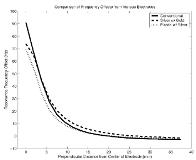EVALUATION OF MR-COMPATIBILITY FOR EEG ELECTRODES
Abstract number :
2.335
Submission category :
Year :
2004
Submission ID :
4784
Source :
www.aesnet.org
Presentation date :
12/2/2004 12:00:00 AM
Published date :
Dec 1, 2004, 06:00 AM
Authors :
1,4Todd K. Stevens, 2,4Seyed M. Mirsattari, 2John R. Ives, and 3,4Robert Bartha
Simultaneous electroencephalography (EEG) and magnetic resonance (MR) research has shown vast potential for investigating partial epilepsy disorders. However, with the increasing trend towards the use of high static magnetic field strenghs and power-intensive pulse sequences, greater magnetic susceptability artifacts and the potential for electrode heating must be considered. The purpose of this study was to evaluate the MR-compatibility of three electrodes based on a quantitative comparison of induced magnetic susceptibility artifacts and electrode heating. To quantify magnetic susceptibility, resonance frequency maps were produced for a spherical saline phantom with a single electrode and lead wire attached using an optimized magnetic field mapping pulse sequence (Magn Reson Med 2004; 51: 881-7) at a static field strength of 4 Tesla. Temperature measurements of the electrodes were acquired using a fiber-optic sensor during the application of research protocol MR experiments, including anatomical and functional gradient echo sequences and a single voxel spectroscopy sequence (all powers calibrated for a human head). Three types of EEG electrodes were sequentially tested: conventional copper (Type 1), pure silver with a gold flash (Type 2), and conductive-plastic coated with a layer of silver epoxy (Type 3). Resonance frequency offsets were plotted as a function of the perpendicular distance from the center of the electrode plane for all three types of electrodes (Fig.1). The maximum frequency offsets for the Type 1, 2 and 3 electrodes were 91 Hz, 74 Hz and 69 Hz, respectively. No significant temperature changes were detected in any of the electrodes for any of the applied pulse sequences (maximum 5 minute power delivered to the RF coil [sim] 9.4 W).[figure1] As expected, the maximum frequency offset for the conventional copper electrode was greater than the offsets for the two silver-containing electrodes. Magnetic field mapping is a promising technique for quantitatively evaluating the severity of susceptibility artifacts induced by EEG electrodes. The spatially dependent frequency information combined with pulse sequence timing parameters can be used to predict the amount of signal loss created by the electrodes for any given MR experiment. (Supported by Natural Science and Engineering Research Council of Canada (NSERC) and Robarts Research Institute. )
